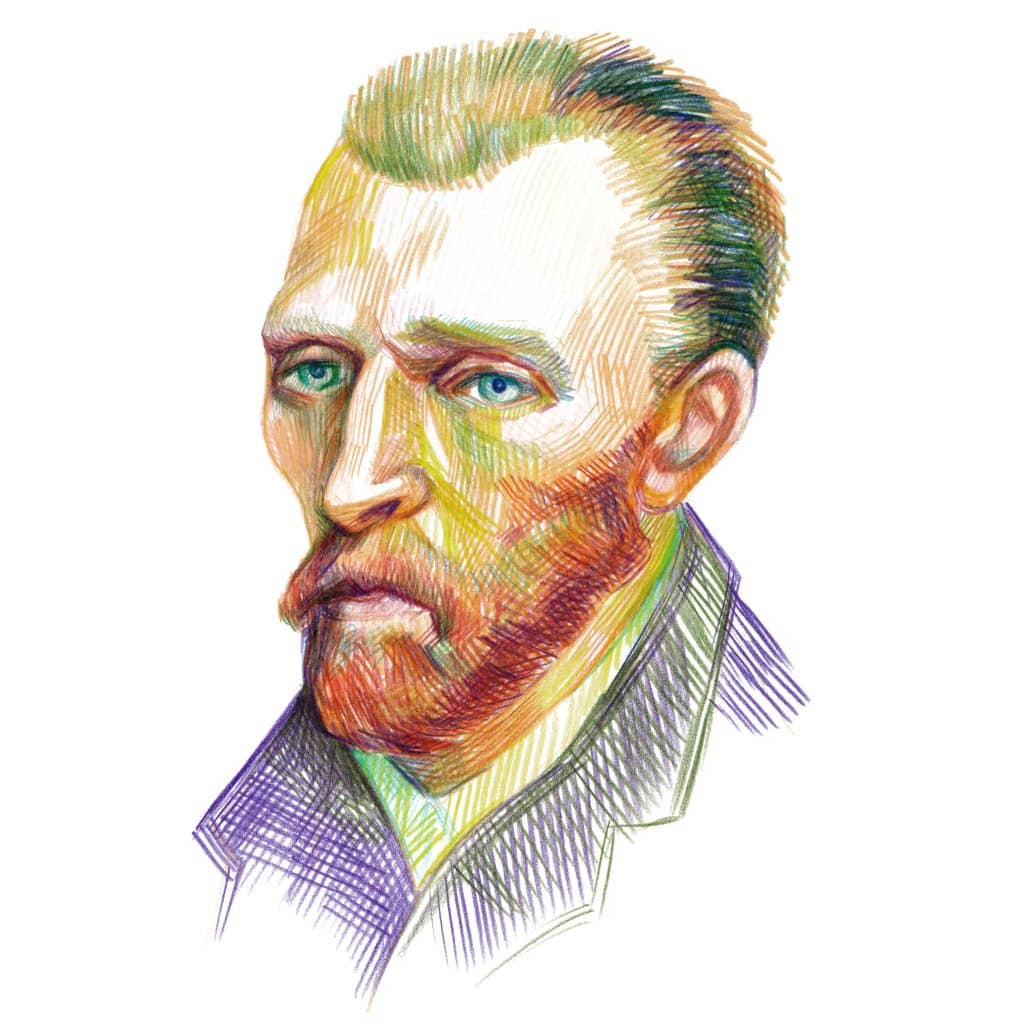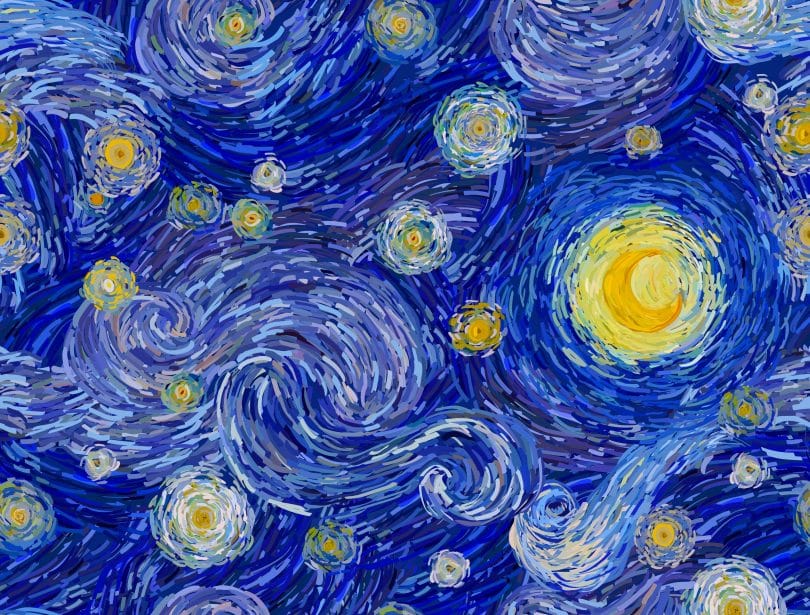If you’re ever lucky enough to visit Amsterdam and go to the Vincent Van Gogh museum, you’ll be blown away by the body of work that this incredible impressionist created in the mid to late 1800s. He was a pure magician with the brush. If you’ve also ever gone to Amsterdam and taken some recreational substances, you may see a few similarities between the way Van Gogh painted the city and how you’ll now witness it too.
The question on many people’s lips is: did the artist take drugs and, if so, which? We’re going to take a look at Van Gogh’s life – both the good and the bad – and see if there’s any evidence to point towards drug use. This might be for inspiration, or it might be for desperation. Let’s take a look.
Who was Vincent Van Gogh?
Before we delve into the question we all want to know, let’s first understand who this incredibly talented artist was. Vincent van Gogh was a Dutch artist who is considered one of the most influential figures in the history of modern art. Born in 1853 in the southern Netherlands, van Gogh grew up in a religious family. He had a difficult childhood and struggled with mental health issues throughout his life. Despite his struggles, van Gogh was passionate about art and began his career as an artist in his late 20s. He started by creating drawings and watercolors, but it wasn’t until he moved to Paris in 1886 that he began to develop his distinctive style of bold colors and expressive brushstrokes. Paris changed Van Gogh:
“Vincent was open to influence and keen to learn. He met Monet, Pissarro and Gauguin. He spent time in cafés (see the Toulouse-Lautrec portrait) discussing with fellow artists, he visited galleries and museums, especially The Louvre, he made contacts.”

His Life
During his time in Paris, van Gogh was heavily influenced by the Impressionist movement and the work of artists such as Claude Monet and Paul Cézanne. He experimented with new techniques and colours, and his paintings began to reflect his own unique vision of the world.
In 1888, van Gogh moved to the southern French town of Arles, where he painted some of his most famous works, including “The Starry Night” and “Sunflowers.” If you’ve never had the pleasure of seeing these artworks, quickly take a look now. They are spectacular. They are characterised by their vibrant colours and swirling, dynamic brushstrokes. Unfortunately, van Gogh’s mental health continued to deteriorate, and he suffered from several breakdowns during his time in Arles.
In 1889, he voluntarily admitted himself to a psychiatric hospital in Saint-Paul-de-Mausole, where he continued to paint but also received treatment for his mental health issues. Unfortunately, Van Gogh’s life was tragically cut short in 1890, when he died by suicide at the age of 37. His paintings, which had been largely ignored during his lifetime, began to gain recognition after his death, and today he is considered one of the greatest artists of all time.
Van Gogh’s Mental Health Struggles
To understand the question of whether Van Gogh used drugs, it’s essential first to understand his mental health struggles. The artist experienced multiple episodes of severe depression and anxiety, which sometimes led to him being hospitalized. He also had a history of alcoholism and substance abuse, which worsened his condition. He was a keen absinthe drinker, and many times included the bottle in his paintings.
But it wasn’t always jolly, some of his most famous works, such as “Starry Night” and “The Potato Eaters,” were created during times of intense emotional turmoil. Van Gogh’s medical history provides some clues about the potential role of drugs in his life. In the late 19th century, when he was alive, mental illness was not well understood, and there were few effective treatments available. In fact, only really recently are we able to even call mental health an illness. Van Gogh received various treatments for his conditions, including psychotherapy, rest, and medications such as bromide, digitalis, and opium. However, these treatments did not provide lasting relief, and Van Gogh continued to experience severe symptoms throughout his life. NIH writes:
“Van Gogh was during his last years exposed to several potentially toxic substances such as; bromides, lead, camphor and terpene oils in absinthe liquor. All of them produce signs of toxicity which are similar to the symptoms known from van Gogh’s attacks of illness; hallucinations, confusion, delirium, convulsions and agitation”
He was known to suffer from a variety of mental health issues – depression, anxiety, BPD, bipolar, insomnia, hallucinations – and these could have led to his suicide in the late 1800s. The question is: were these substances taken to deal with these feelings, or were they the cause?
While there is no direct evidence that Van Gogh used drugs, some scholars have speculated that he may have experimented with substances to alleviate his symptoms.
Absinthe
As mentioned earlier, the most commonly suggested drug is absinthe, a green-coloured alcoholic drink that was popular in France in the late 19th century. Absinthe contains thujone, a chemical compound that is believed to have psychoactive effects. Some people believed that absinthe could inspire creativity, and it became known as the “Green Fairy.” Absinthe, if you’ve ever had it, is extremely strong – sometimes reaching up to 75-80% alcohol. Some believe he must have used absinthe for inspiration, and point to the inclusion of bright green and blue tones in some of his paintings, which could be interpreted as a nod to the drink’s distinctive colour. However, there is no direct evidence that Van Gogh was significantly affected by absinthe, and many other artists of his time also consumed the drink without experiencing any significant impact on their work.
Thank you for stopping in. Head over to the Cannadelics Weekly Newsletter for direct updates; and get access to awesome deals on cannabis buds, vapes, edibles, smoking devices and equipment, cannabinoid compounds, and some psychedelic products! Go get high responsibly!
The Use of Drugs
Cannabis
Another substance that has been suggested as a possible influence on Van Gogh’s art is cannabis. The artist lived in the Netherlands, where cannabis was legal until the early 20th century, and he may have been exposed to the drug through his social and artistic circles. Some of Van Gogh’s works feature swirling patterns and distorted perspectives, which could be interpreted as a possible influence of cannabis on his perception. Technically, there is no direct evidence to support this theory. Although, as I’ve said, the images he draws are very similar to how the cobbled streets of Amsterdam look after a joint or two. Coincidence or not? You decide.
Opium
Some have suggested that Van Gogh may have consumed opium both as a painkiller and a recreational drug. During his time in the south of France would probably have been a time where he would have had easy access to it. The likes of Picasso, and other creatives, were known to use it to inspire creativity. However, there is little evidence to suggest that Vincent used it himself.

The End
Van Gogh died at the early age of 37. It is likely, had he lived longer, he would have continued to create incredible pieces of work. However, for whatever reason, he felt he could no longer endure the pain of his life. The Museum of Van Gogh writes:
“Vincent van Gogh took his own life in July 1890. He felt he couldn’t go on. The immense demands he made of himself, his obsessive labor, his mental illness and, not least, his changing relationship with his brother had all become too much. Vincent wrote to Theo: ‘I feel – a failure. I feel that that’s the fate I’m accepting, and which won’t change any more.’”
His brother, Theo, meant a lot to him, and they continued to write to each other throughout their lives. But this was the last. The truth is, like many other artists of the time, Van Gogh was only truly appreciated after his death. He could live on his work, but the fame he now receives is unmatched of course. In a sense, he was struggling with the image he had of himself and his work, and the reception he received.
Van Gogh – Legacy
Van Gogh’s legacy is marked by his incredible talent, his unique style, and his struggles with mental health. He is considered to be one of the most significant artists of the 19th century. He produced more than 2,000 paintings and drawings in a career spanning just a decade.
Regardless of whether Van Gogh used drugs, his life and work continue to inspire artists and everyday folk around the world. Like many other creatives of his time – and still today – he may have dabbled in substance use. But nonetheless, the effort should not be in labelling an artist a drug user, but instead in understanding the issues and effects of mental health.
Thanks for making your way over! We appreciate you stopping in at Cannadelics.com; where we work to bring you the best in independent news coverage for the cannabis and psychedelics spaces. Visit us regularly for daily news, and sign up to the Cannadelics Weekly Newsletter, so you’re always on top of what’s going on.







